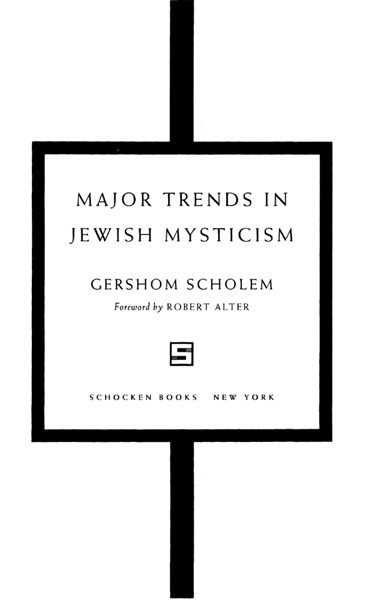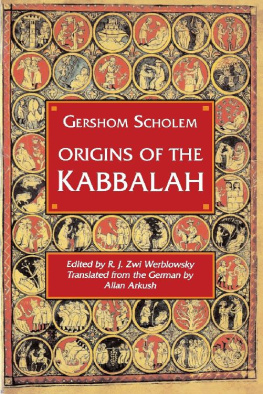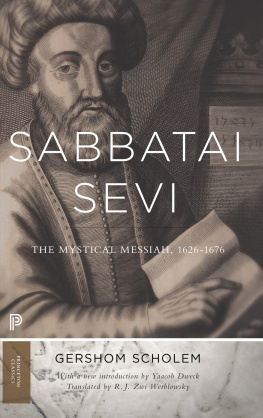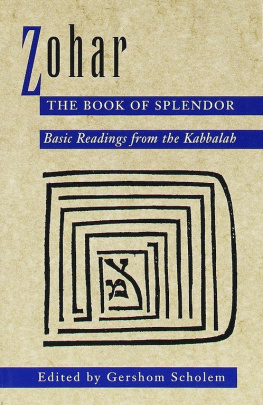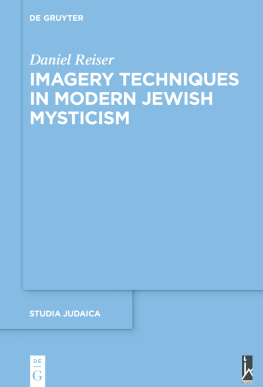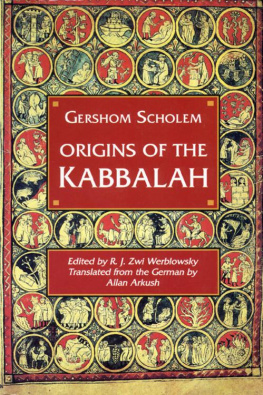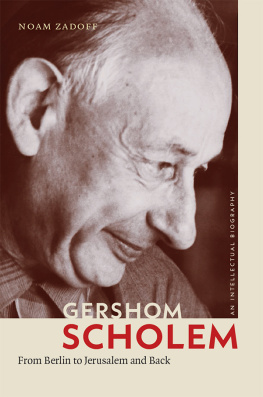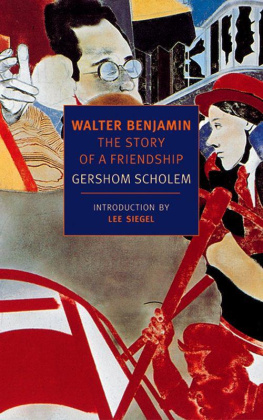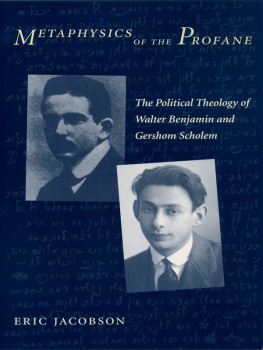Copyright 1946, 1954 by Schocken Books Inc.
Copyright renewed 1974 by Schocken Books Inc.
Foreword copyright 1995 by Robert Alter
All rights reserved under International and Pan-American Copyright
Conventions. Published in the United States by Schocken Books Inc.,
New York. Distributed by Pantheon Books, a division of Random
House, Inc., New York. Originally published in Israel by Schocken Publishing
House, Ltd., Jerusalem, in 1941. Copyright 1941 by Schocken Publishing House, Ltd.
Major Trends in Jewish Mysticism is based on the Hilda Strook Lectures delivered
by Professor Scholem at the Jewish Institute of Religion, New York.
Library of Congress Cataloging-in-Publication Data
Scholem, Gershom Gerhard, 1897-1982
Major trends in Jewish mysticism / by Gershom Scholem;
foreword by Robert Alter.
p. cm.
Previously published: New York : Schocken Books, 1961. With new foreword.
eISBN: 978-0-307-79148-1
1. MysticismJudaism. 2. CabalaHistory. I. Title.
BM723.S35 1995
296.8333dc20 95-2182
v3.1_r1
TO THE MEMORY OF
WALTER BENJAMIN
(18921940)
The friend of a lifetime whose genius united the insight
of the Metaphysician, the interpretative power of the Critic
and the erudition of the Scholar
DIED AT PORT BOU (SPAIN)
ON HIS WAY INTO FREEDOM
Contents
Purpose of these lectures. What is Mysticism? The paradoxical nature of mystical experience. Mysticism as an historical phenomenon. Mythology, Religion and Mysticism. Mystical interpretation of religious values. Jewish Mysticism influenced by the positive contents of Judaism. The Kabbalistic theory of the hidden God and His attributes. The Sefiroth. The Torah. Kabbalism and language. Mysticism and the historical world. Cosmogony and eschatology. Jewish Philosophy and Kabbalism. Allegorization and symbolism. Philosophical and mystical interpretation of Halakhah and Aggadah. Kabbalism and prayer. Mythical elements in Kabbalistic thought. The resurrection of myth in the heart of Judaism. The absence of the feminine element in Jewish Mysticism.
The first period of Jewish Mysticism. Anonymity of the writings. Esoterism of the Mishnah teachers. Throne-mysticism. Apocalyptic and mysticism. The literature of the Hekhaloth-books. The Yorde Merkabah and their organization. Conditions of initiation. The ecstatic ascent of the soul and its technique. Magical elements. Dangers of the ascent. God as Holy King. The hymns of the Merkabah mystics. Shiur Komah. Enoch, Metatron and Yahoel. The cosmic curtain. Remains of Gnostic speculations on aeons. The Book of Creation. Theurgy. Moral re-interpretation of the Merkabah.
The rise of Hasidism in Germany. Mystical tradition and German Jewry. The Book of the Devout. Jehudah the Hasid and his disciples. Eschatological character of Hasidism. The new ideal of the Hasid: Ascetics, ataraxy and altruism. Love of God. A Judaized version of monkish Cynicism. The magic power of the Hasid. The Golem legend. Mysteries of Prayer. Occultist practices. Hasidic conception of penitence. The conception of God in Hasidism. Immanence of God. Kavod, the Divine Glory. Traces of the Philonic doctrine of the Logos. The Cherub on the throne. Holiness and Greatness in God. The aim of prayer. The cosmic archetypes.
Emergence of Kabbalism. Types of Kabbalists. Kabbalistic reticence and censorship. Vision and ecstasy. The conception of Devekuththe Jewish form of mystical union. Life and work of Abraham Abulafia. His theory of ecstatical knowledge. The science of combination. The music of pure thought. The mystical nature of prophecy. Prophetic Kabbalism. Mystical transfiguration as the essence of ecstasy. Mystical pragmatism. Practical Kabbalism and magic. Later developments of Abulafias doctrines. Translation of an autobiography written by a disciple of Abulafia.
The problem of the Zohar. Literary character and composition of the Zohar. The whole of the Zoharic literature consists of two major parts: the bulk of the Zohar and the Raya Mehemna. The bulk of the Zohar the work of one author. Evidence of unity. The language and style of the Zohar. Its stage-setting. Pseudo-realism. Principles of literary composition. Sources of the Zohar: the real and fictitious ones. Treatment of the sources. The authors predilection for certain Kabbalistic doctrines and dislike for others. Absence of the doctrine of the Shemitahs, or units of cosmic development. Stages in the composition. The Midrash Ha-Neelam as the oldest constituent of the Zohar. The Midrash Ha-Neelam written between 1275 and 1281; the bulk of the Zohar between 1281 and 1286; the Raya Mehemna and Tikkunim about 1300. The question of the personality of the author. Moses ben Shemtob de Leon. The old testimonial on his authorship. Moses de Leon and Joseph Gikatila. Comparison of Moses de Leons Hebrew writings with the bulk of the Zohar. Identity of the author of all these writings. Other Kabbalistic pseudepigrapha written by Moses de Leon. Veiled references to his authorship of the Zohar in Moses Hebrew writings. Moses de Leons spiritual development and his motives in writing the Zohar. Pseudepigraphy a legitimate category of religious literature.
The difference between Merkabah Mysticism and Spanish Kabbalism. The hidden God or En-Sof. The Sefiroth, the Realm of Divinity. Mystical conception of the Torah. Symbolical realization of the Sefiroth. Some instances of Kabbalistic Symbolism. God as a mystical organism. Nothing and Being. The first three stages of the Sefirotic development. Creation and its relation to God. Theogony and Cosmogony. Pantheistic leanings of the author of the Zohar. The original nature of Creation. Mythical imagery in Kabbalistic thought. The problem of sexual symbolism. The new idea of the Shekhinah as a feminine element in God and as the mystical Community of Israel. Man and his Fall. Kabbalistic ethics. The nature of evil. The Zohar and Jacob Boehme. Psychology of the Zohar. Unity of theosophy, cosmology and psychology.
The Exodus from Spain and its religious consequences. Kabbalism on its way to Messianism. Apocalyptic propaganda by Kabbalists. The character and function of the new Kabbalism. Its center in Safed, Palestine. Moses Cordovero and Isaac Luria. Their personalities. Spread of Lurianic Kabbalism. Israel Sarug. Characteristics of the Lurianic doctrine. Tsimtsum, Shevirah and Tikkun. The twofold process of Creation. The withdrawal of God into Himself as the starting-point of Creation. Meaning of this doctrine. The primordial catastrophe, or Breaking of the Vessels. The origin of Evil. Two aspects of the theory of the Tikkun, or restoration of harmony. The mystical birth of the personal God and the mystical action of man. The emergence of theosophic worlds, and their relation to God. Theism and Pantheism in Lurias system. Mystical reinterpretation of Messianism. The doctrine of mystical prayer. Kawwanah. Mans role in the Universe. Lurias psychology and anthropology. The Exile of the Shekhinah. The uplifting of the holy sparks. Transmigration of the soul and its place in the Kabbalism of Safed. Influence of Lurianic Kabbalism. A great myth of Exile and Redemption.
The Sabbatian movement of 16651666. Sabbatai Zevi, the Kabbalistic Messiah, and Nathan of Gaza, his prophet. Sabbatai Zevis illness and its mystical interpretation by Nathan. Quasi-sacramental character of antinomian actions. Lurianism adapted to the personality of the new Messiah. Heretical turn of the movement after the apostasy of Sabbatai Zevi. Importance of Sabbatianism for Jewish history. A revolution of the Jewish consciousness. Connection between heretical Kabbalism and Enlightenment. The Sabbatian ideology. A religion of paradoxes. Historical and mystical aspects of Redemption. Their clash after Sabbatai Zevis apostasy. Sabbatianism and Christianity. Influence of Marranic psychology on Sabbatianism. Doctrine of the necessary apostasy of the Messiah. The problem of antinomianism. Moderate and radical forms of Sabbatianism. Mystical nihilism and the doctrine of the Holiness of Sin. The new conception of God: the first cause, or the God of Reason, and the first effect, or the God of Revelation.


